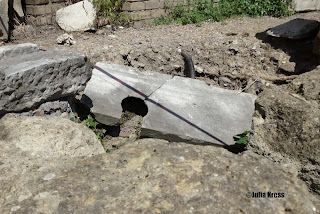 |
| Temple B at Largo Argentina |
The Ides of March is still remembered today, the day Julius Caesar was murdered. This murder is reported by literary sources as happening in the Senate House. The curious thing is that the senate didn't just meet in the official Senate House. The location of where the senate met on that fateful of Ides of March 44 BCE, is open for view any time of the day or night in the center of Rome at Largo Argentina, behind so-called Temple B. Specifically, if you want to see the place of Julius Caesar's murder, go to Via Torre Argentina and stand with your back toward the Teatro Argentina. Look down and spot the remnants of the Roman latrine located here. No, Julius Caesar wasn't murdered in the latrine, but a floor above it. However, these two levels have collapsed into one in the ruins behind Temple B, the very outer edge of Pompey's theater.
 |
| remains of an ancient latrine |
I am fortunate to know the ruins at Largo Argentina because I spent three weeks working on measuring and drawing one of the columns of Temple A in order to document it and help detangle the layers of history associated with this temple. The project I was participating in is through the American Academy in Rome's Summer Archaeology Program, called Documentation and Analysis of Ancient Buildings, led by Stephan Zink and Jens Pflug. It is offered every other summer.
 |
| Temple A at Largo Argentina |
The so-called Temple A is one of four Republican-era temples in Largo Argentina along with part of the Theater of Pompey, a private Roman house and the public latrine. This site has many different time periods built on top of one another since the area was raised in with fill at least twice. The reasons for raising the ground level here has do with flooding from the Tiber and it is known that the entire area was raised after the fire of 64 CE.
 |
| Column with original base, bricks used to raise the level and Imperial remains are white marble |
Italian archaeologist Giacomo Boni worked on excavating the site in the late 1800s. However, since his notes on the site cannot be deciphered, many questions remain about the four temples, including each temple's name. The most famous find from the site was found in 1925 near temple B - a massive head of a goddess. This head is on view at the Centrale Montemartini museum, Via Ostiense 106.
 |
| Joanna Mundy working on measuring and documenting Temple A |
The Republican-era remains of Temple A were my favorite part, located underneath the temple in its basement. It was exciting putting on a hard hat and going underneath the temple. It was cold and damp with a stagnant smell. Amazingly, once in the lower level of the temple, there are three original temple steps that I was able to walk up to the original podium of the temple where the ancient altar still sits, covered in old moss. When I saw the ancient altar, there was a scorpion on it. It seemed very appropriate.
 |
| Temple A's original altar |
 |
| the scorpion on the altar |
Today, Largo Argentina is a huge square lined with a large bookstore, the wonderful Feltrinelli's, which has a good English language book section, a multitude of cafes, a fantastic place to get pizza by the slice, banks and shops. The large archaeological pit containing the four temples fills the middle of the square, with Temple A on the far north side of the site where once the church of St. Nicholas stood, its asp still visible. The Torre di Papito, a medieval tower that dates from the 12th century still remains on the south end of the site.
 |
| Me and the column (to the right) that I worked on at Temple A |
If you like cats, make sure to take the steps down to the Torre Argentina Cat Sanctuary to see the cats that live in the ruins. You can also check them out online at www.romancats.com/torreargentina/en/introduction.php.
For more details look at Amanda Claridge's Oxford Archaeological Guide to Rome, pages 215-219, and Filippo Coarelli's Rome and Environs: An Archaeological Guide, pages 275-281. For more information on the web, see http://www.livescience.com/23900-julius-caesar-assassination-place-discovered.html



No comments:
Post a Comment